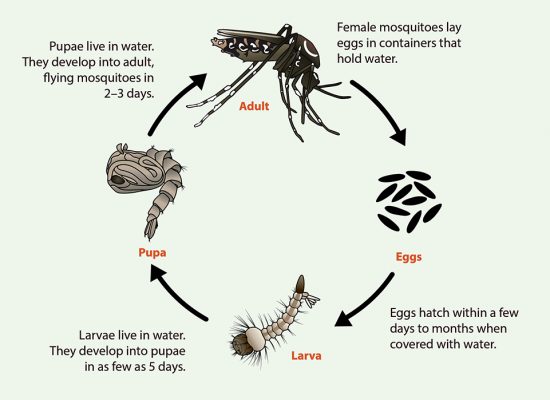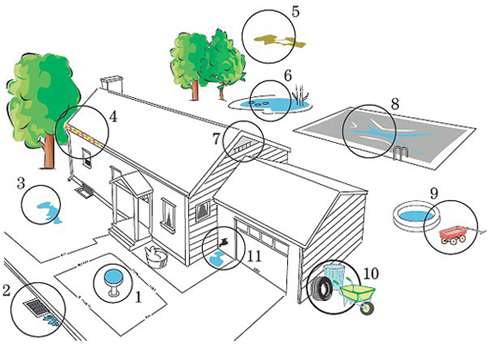Mosquito Control
Mosquitoes are insects that initially develop in the water and later hatch out as adults. Most of the time, mosquitoes are a nuisance but they have also been implicated in the transmission of many diseases. Click here for Mosquito Transmitted Disease Surveillance Program information. There are typically 15 species of common mosquitoes found in Ventura County. Many of these have specific habitats: some may prefer creeks or marshes, others prefer gutters or catch basins, and still others may prefer saucers under potted plants or other objects holding water in and around the home. Not all mosquitoes bite man.
There are also additional flying insects that may be mistaken for mosquitoes. These may be black flies, midges or gnats. For more information on insects resembling mosquitoes, click here. If you are being bitten, it is important to collect samples of what is biting you. Using a sample, the department can then determine what the insect problem is, and get a hint about where they might be developing..
How Do Mosquitoes Breed?
All mosquitoes require water in which to pass their early life stages (eggs, larva, and pupal stages); this usually takes from 7 to 10 days.
Most mosquitoes lay their eggs in standing water, where they hatch in a day or two. This may be along creek margins, in containers, gutters, tires, and ponds. Any location where water stands for over one week may become suitable for mosquito breeding. Some species have eggs that stick to the sides of containers, objects, or water-holding plants and can remain viable for very long periods until they get wet and hatch.
The mosquito eggs hatch into the larval stage (also called wigglers). Where the larva wiggle through the water, feeding on minute particles. This stage lasts for about one week. The larva then changes into the pupal stage (called tumblers). This stage is where the larva changes into the adult mosquito. When the adult mosquito is ready to emerge, the skin of the pupa splits open, and the adult mosquito climbs out.
Adult mosquitoes usually live for two weeks but may survive the winter in the adult stage. They frequently rest in grasses, shrubbery, or other foliage, and in shaded, secluded, or protected areas, for example, doghouses, chicken coops, under eaves, etc. The adult mosquito will feed on flower nectar, which is used for food and energy. The female mosquito may need blood meals for their egg development. This is when potential diseases are transmitted. The male mosquito does not bite or need a blood meal.
How Do I Control Mosquitoes? Where Do I Look?
You may be raising Mosquitoes!
Homeowners can help reduce annoyance caused by mosquito breeding around their homes by eliminating standing water. Start with a thorough inspection of your property to determine sources of standing water.
Here are some places to check:
- Stagnant water located in birdbaths should be changed twice weekly.
- Yard waste, such as lawn cuttings and raked leaves, which are present in gutters or storm drains, prevent water from flowing and harbor perfect breeding conditions for mosquitoes.
- Low-lying depressions in lawn areas where water can collect should be filled in.
- Leaves and twigs can block roof gutters and eaves troughs and prevent proper water drainage.
- Compost should be turned over frequently, and areas of organic matter, which provide a food source for nuisance fly larvae, should be collected and recycled immediately.
- Ornamental ponds should be stocked with mosquito fish.
- Open or broken window screens and attic vents offer perfect avenues for mosquitoes to make their way into your home. Window screens should fit snugly into the frame, vents should remain closed, and for further prevention, windows should also be shut during the hours of dusk and dawn.
- Pool covers can collect water and should be emptied right away. Wading pools need to also be turned over when they are not in use.
- Toys and other objects around the yard should be placed in an area where they won’t collect rainwater.
- Mosquitoes are often attracted to containers of standing water, like wheelbarrows or tires that are left outside. To avoid this, drill holes in the bottom of containers to allow water to flow out or turn over those items that are not in use.
- Leaky faucets should be closed tightly as water build-up can create breeding grounds for mosquitoes.
Other possible mosquito breeding sources include:
Water-holding containers of any kind
- Get rid of or empty out old tires, tin cans, buckets, bottles, jars, drums, tarps, etc. Small boats, wheelbarrows, etc., should be stored upside down.
Wading pools/swimming pools
- Children’s wading pools should be emptied weekly and stored indoors when not in use. Infrequently used swimming pools should be emptied or tightly covered. The pool covers may also collect rainwater; these should be drained, also. Pool water should be properly disposed of. Cities may require permits to drain your pool.
Water dishes and birdbaths
- Change water dishes of pets and chickens daily, change water in birdbaths twice weekly. Animal pens should be kept free from any standing water.
Cut flowers
- Change water in vases twice weekly (both inside and outside the house).
Roofs and Gutters
- Check roof gutters and drain pipes to see if any are plugged or sagging. Flat roofs should also be checked for standing water, and roof drains inspected to insure they are free of obstructions. Clean or fix as needed.
Leaky Faucets and hoses
- Repair all leaking exterior faucets, hose nozzles, and connections.
Drainage Basins
- Monitor sump pits, dry wells, or drainage basins as needed to eliminate stagnant water where mosquitoes can breed.
Cesspools and septic tanks
- Insure that cesspools or septic tanks are operating properly and not overflowing. The covers should fit tightly. Failed septic systems must be repaired or connected to the public sewer system when and where available.
Ornamental ponds
- Consider stocking ponds with mosquito fish.
Creeks and drains
- Be sure to keep creeks and drains open free of grass, plants, leaves, trash, algae, or other material that may be blocking the water flow.
Hollow tree stumps or tree holes
- Monitor hollow tree stumps or tree holes for water accumulation that may lead to mosquito breeding. A dead tree stump may be filled with sand. If mosquitoes continue to bother you and you have eliminated the mosquito breeding sources around your house, the source may be off of your property.
- These problems should be reported to the Vector Control Program of the Ventura County Environmental Health Division.
Stormwater and Flood Control Basins
- Management of mosquitoes in stormwater management structures, such as flood control basins, is critical for protecting public health. The California Department of Public Health has a Checklist for Minimizing Vector Production in Stormwater Management Structures.
How Are Mosquitoes Controlled?
- Mosquitoes are generally controlled in the larval and pupal stages. Adult stages may also be controlled during public health emergencies. The type of control will need to be targeted to the stage of the mosquito that is present. The Ventura County Vector Control Program uses physical, natural, biological, and chemical control measures to reduce the risk of mosquito-borne disease.. The Vector Control Program also stocks and supplies mosquito fish for the control of mosquito larvae and pupae. The Vector Control Program inspects and monitors over 2,000 mosquito breeding sites throughout the County on public and private property.
Physical control
- This consists of filling in small puddles, opening up of blockages in creeks to restore the water flow, raking out algae or other debris etc. This eliminates the source or makes the site less desirable for mosquito egg laying.
Cultural control
- Many sites may be made less desirable for mosquito breeding by altering the management of the site or the habitat. For example, having less vegetation in the water may allow natural predators to control the mosquito larva better.
Biological control
- Biological control agents include predatory fish, predatory aquatic invertebrates, and mosquito pathogens such as certain species of bacteria. Bacterial larvicides are highly target-specific, typically safe for non-target organisms, and break down rapidly in the environment.
Mosquito Fish
- Mosquito fish (Gambusia affinis) are surface-feeding fish that are ideal for mosquito control. They may be used in abandoned swimming pools, ponds, or other confined water sources where mosquito problems are occurring. The Vector Control Program delivers mosquito fish upon request (Call 805-662-6582). Depending on the size of the pool, it may take the mosquito fish one or two months before they multiply into sufficient numbers to control all of the mosquitoes. Additional control may be needed if mosquito breeding is occurring. For more information on mosquito fish, click here for a brochure and here for more information on this website.
Chemical control
- Chemical control may be used to control either the aquatic or the adult mosquito stages. The Vector Control Program uses surfactants to control late larval and pupal stages that no longer feed and are not affected by bacterial larvicides that must be ingested and products containing methoprene to obtain long-term control in appropriate breeding sources. The Program does not use adulticides in normal operations but may do so in the case of a public health emergency or to try to prevent the establishment of invasive species.
The Role Of The Environmental Health Division
- The Vector Control Program of the Environmental Health Division monitors and controls mosquito breeding in such areas as flood control channels, drains, roadsides ditches, catch basins, gutters, creeks, marshes, retention and detention basins, pools and rainwater depressions. The Vector Control Program depends on public participation to eliminate backyard-breeding sources. The Environmental Health Division also maintains an encephalitis virus surveillance program throughout Ventura County. Adult mosquitoes are trapped and submitted for laboratory analysis to detect the presence of the viral diseases West Nile, St. Louis encephalitis, and western equine encephalomyelitis. Specific traps are deployed to target invasive Aedes species, which, if found in Ventura County, can be submitted for testing for Zika. Four sentinel chicken flocks are used to monitor the potential transmission of encephalitis by mosquitoes. These are located in Camarillo, Thousand Oaks, Simi Valley, and the Fillmore area.




